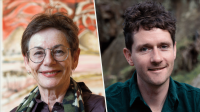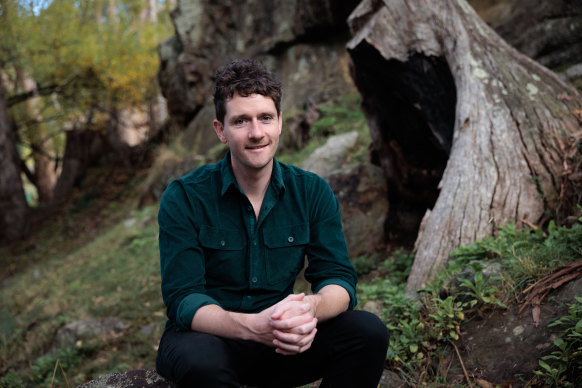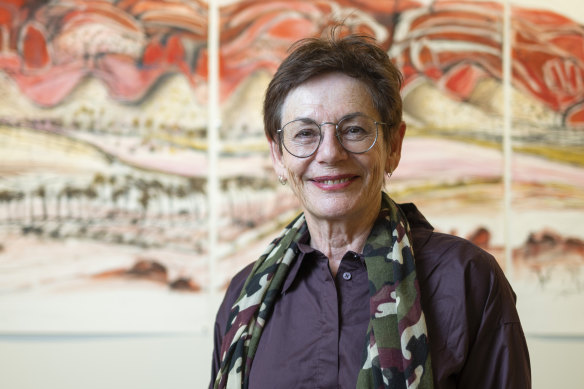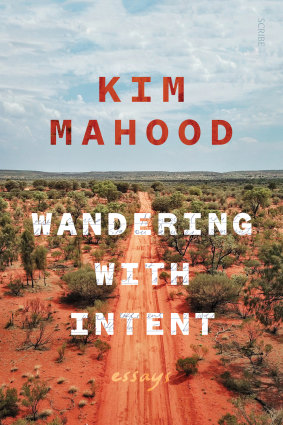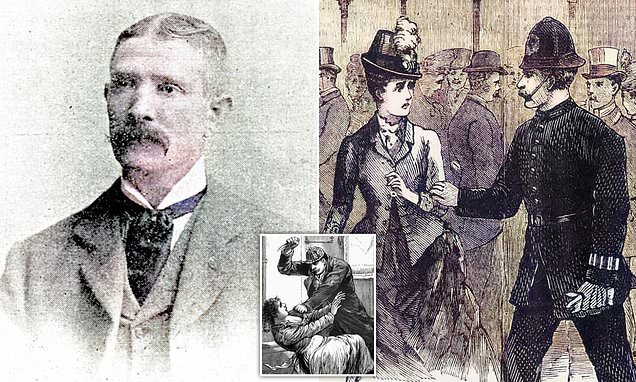Save articles for later
Add articles to your saved list and come back to them any time.
Robbie Arnott never forgot the stories his grandfather told him about growing up on an orchard in Tasmania. They were simple tales, but Arnott thought they were like myths of a forgotten age.
So, when he came to write his third novel, Limberlost, he based Ned, his teenage protagonist on the life of his grandfather. Now Limberlost has won Arnott The Age fiction book of the year, an award he won two years ago for his second novel, The Rain Heron. Anott said he was “pretty blown away” by winning.
Judges of the Age book of the year said Robbie Arnott’s writing about the natural world was typically adept.Credit: Peter Mathew
Kim Mahood, an artist and writer who grew up on stations in Central Australia won the non-fiction award for her essay collection, Wandering with Intent. She writes about the challenging issues at the interface between Indigenous and white communities.
She is also a repeat winner, having won in 2000 for her memoir Craft for a Dry Lake, her first writing prize. But she was surprised to win again, she said, because the literary and publishing community were increasingly risk-averse to people such as her writing about contentious areas.
The awards were presented at the Town Hall on Thursday evening by The Age’s editor Patrick Elligett at the opening of the Melbourne Writers Festival. Each of the winners receives $10,000 thanks to the Copyright Agency’s cultural fund. The judges were poet Thuy On; Miles Franklin-shortlisted novelist Michael Winkler; author Michael McGirr; and author and critic Simon Caterson.
Arnott’s novel begins with Ned living on Limberlost, the family orchard, with his father and sister during World War II. His brothers go to war, and he starts shooting rabbits to raise money to help pay a vet bill for an injured horse and to buy a dinghy made of coveted Huon pine. The novel follows Ned throughout his life.
Kim Mahood is uncertain about continuing with her sort of writing and is thinking of writing more fiction.Credit: Martin Ollman
The judges said Arnott’s writing of the Tasmanian landscape was typically adept and praised his “sturdy writing about humble, decent people. This is the work of an author sufficiently confident in his powers that he tailors his style to the story. In so doing he has produced a gem sure to give readers joy for years to come”.
The judges said Mahood explored the issues’ depths and complexities without resorting to cliches or humbug. “She is clear-sighted, compassionate, readily amused but not easily fooled … Each essay is superbly crafted.”
Credit:
Arnott, who works in an advertising agency in Hobart, said he was touched by how so many readers had related to Limberlost. “I worried that this wasn’t going to make sense to some people because I focused on one person, but there seems to be a universality to that experience which has been really humbling.”
But Arnott pointed out that while his grandfather Bruce did spend a summer shooting rabbits to earn money, as always with fiction he had tinkered with the element of reality to suit the demands of drama and story.
As with his previous novels, The Rain Heron and Flames, Arnott writes evocatively about the natural world. But, he says, it’s not so much how it’s experienced by his characters, “it’s about how it feels. I try and focus on what the emotion is being in a place”.
The magical realist element of those earlier books is absent from Limberlost, which is written in a more straightforward style. “It wasn’t necessary or required for this story. I never set out to write in a specific genre or style, it’s more what I feel the story needs or what I feel will enhance whatever I’m trying to do.”
Mahood, who travelled from Alice Springs to receive the award, is first and foremost an artist and has pioneered cultural and environmental mapping done in conjunction with Indigenous communities. Her maps are large – up to three metres long and almost the same wide – “and they work as a sort of facsimile of country; you lay them down, you sit on them”.
Credit:
“People are very invested in creating them as both beautiful objects and a source of a lot of knowledge,” she said.
“You’re paying attention first and foremost to what’s important to the Aboriginal people because they’re cross-cultural documents, to be worked as a communication tool. But the primary thing is what’s important to people, what they feel comfortable about putting on a map.”
As someone who spends months each year in Indigenous communities, Mahood is frequently asked about the Voice referendum.
“My answer is that the Voice is not going to be a silver bullet and there may well be a lot of complications, but a no vote would just be catastrophic. The message it would send would set back the relationships between Indigenous and white Australia. It could be irreconcilable.”
Nevertheless, she said some of the remote communities would still be baffled about the Voice “if they’ve even heard of it”.
“I’m not sure the message is getting through to the people like the desert mob. I think if you can get some of those desert people stepping up and speaking about it from their point of view, that would add to the yes campaign enormously. I think that’s the thing that’s missing from the public perception at this stage.”
Mahood is uncertain about her writing future and is considering more fiction; she has written short stories. She reckons the things that interest her – the complex relationships and situations involving the Indigenous and white communities – could be better dealt with in fiction.
“I am probably one of the few people that could write that stuff and still get published as a white person.”
The Age is a partner of the Melbourne Writers Festival.
The Booklist is a weekly newsletter for book lovers from books editor Jason Steger. Get it delivered every Friday.
Most Viewed in Culture
From our partners
Source: Read Full Article
